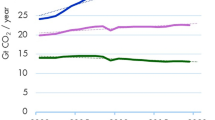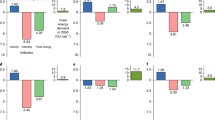Abstract
We report results from the application of an integrated assessment model, MiniCAM 1.0. The model is employed to explore the full range of climate change implications of the successful development of cost effective, advanced, energy technologies. These technologies are shown to have a profound effect on the future magnitude and rate of anthropogenic climate change. We find that the introduction of assumptions developed by a group of ‘bottom-up’ modelers for the LEESS scenarios into a ‘top-down’ model, the Edmonds-Reilly-Barns Model, leads to ‘top down’ emissions trajectories similar to those of the LEESS. The cumulative effect of advanced energy technologies is to reduce annual emissions from fossil fuel use to levels which stabilize atmospheric concentrations below 550 ppmv. While all energy technologies play roles, the introduction of advanced biomass energy production technology is particularly important. The consideration of all greenhouse related anthropogenic emissions, and in particular sulfur dioxide, is found to be important. We find that the consideration of sulfur dioxide emissions coupled to rapid reductions in carbon dioxide emissions leads to higher global mean temperatures prior to 2050 than in the reference case. This result is due to the short-term cooling impact of sulfate aerosols, which dominates the long-term warming impact of CO2 and CH4 in the years prior to 2050. We also show that damage calculations which use only mean global temperature and income may be underestimating damages by up to a factor of five. Disaggregating income reduces this to a factor of two, still a major error. Finally, the role of the discount rate is shown to be extraordinarily important to technology preference.
Similar content being viewed by others
References
Alcamo, J., Bouwman, A., Edmonds, J., Grübler, A., Morita, T., and Sugandhy, A.: 1995, ‘An Evaluation of the IPCC IS92 Emission Scenarios’, in Climate Change 1994: Radiative Forcing of Climate Change and An Evaluation of the IPCC IS92 Emission Scenarios: 245–304. Cambridge University Press, London, UK.
Boer, G.J., McFarlene, N.A., and Lazare, M.: 1992, ‘Greenhouse-gas-induced Climate Change Simulated with the CCC Second-Generation General Circulation Model’, Journal of Climate, 5 1045–1077.
Cubasch, U., Hasselmann, K., Höck, H., Maier-Reimer, E., Mikolajewicz, U., Santer, B.D., and Sausen, R.: 1992, ‘Time-Dependent Greenhouse Warming Computations With a Coupled Ocean-Atmosphere Model’, Climate Dynamics 8 55–69.
Edmonds, J., and Barns, D.W.: 1992. ‘Estimating the Marginal Cost of Reducing Global Fossil Fuel CO2 Emissions’, Energy · Environment · Economics 2(2) 1–16.
Edmonds, J., and Reilly, J.: 1985, Global Energy: Assessing the Future, Oxford University Press, New York, 317pp.
Grubb, M., Edmonds, J., ten Brink, P., and Morrison, M.: 1993, ‘The Costs of Limiting Fossil-Fuel CO2 Emissions: A Survey and Analysis’, Annual Review of Energy and Environment 18, 397–478.
Haarsma, R.J., Mitchell, J.F.B. and Senior, C.A.: 1993, ‘Tropical Disturbances in a GCM’, Climate Dynamics 8, 247–257.
Hansen, J., Lacis, A., Rind, D., Russell, G., Stone, P., Fung, I., Ruedy, R., and Lerner, J.: 1984, ‘Climate Sensitivity Analysis of Feedback Mechanisms’, in Climate Processes and Climate Sensitivity, (eds.) Hansen, J. and Takahashi, T., Geophysical Monograph No. 29. American Geophysical Union, Washington, DC. pp. 130–163.
Hulme, M., Jiang, T., and Wigley, T.: 1995, SCENGEN: A Climate Change SCENario GENerator: Software User Manual, Version 1.0. Climate Change Research Unit, School of Environmental Sciences, University of East Anglia, Norwich, UK.
IPCC (Intergovernmental Panel on Climate Change), 1996a, Climate Change 1995: The Science of Climate Change. The Contribution of Working Group I to the Second Assessment Report of the Intergovernmental Panel on Climate Change. J.P.Houghton, L.G.Meira Filho, B.A.Callendar, A.Kattenberg, and K.Maskell (eds.). Cambridge University Press, Cambridge, UK.
IPCC (Intergovernmental Panel on Climate Change), 1996b, Climate Change 1995: Economic and Cross-Cutting Issues. The Contribution of Working Group III to the Second Assessment Report of the Intergovernmental Panel on Climate Change. J.P.Bruce, H.Lee, and E.F.Haites (eds.). Cambridge University Press, Cambridge, UK.
IPCC (Intergovernmental Panel on Climate Change), 1992, Climate Change 1992: The Supplementary Report to the IPCC Scientific Assessment. J.T.Houghton, B.A.Callander and S.K.Varney (eds.), Cambridge University Press, Cambridge, UK.
IPCC (Intergovernmental Panel on Climate Change), 1991, Climate Change: The IPCC Response Strategies. World Meteorological Organization/United Nations Environmental Program. Island Press, Washington DC.
Johansson, T.B., Kelly, H., Reddy, A.N., and Williams, R.H.: eds. 1993, Renewables for Fuels and Electricity. The United Nations Solar Energy Group for Environment and Development, n.d.
Johansson, T.B., Ishitani, H., Williams, R.H., and Edmonds. J.A.: 1996, ‘Options to Reduce Carbon Emissions from the Energy Supply Sector’, Energy Policy (forthcoming).
Lashof, D.A., and Tirpak. A.D.: 1989, Policy Options for Stabilizing Global Climate, Draft Report to Congress, U.S. Environmental Protection Agency, Office of Policy, Planning and Evaluation, Washington D.C.
Leggett, J., Pepper, W.J., Swart, R.J., Edmonds, J., Meira Filho, L.A., Mintzer, I., Wang, M.X., and Wasson, J.: 1992, ‘Emissions Scenarios for the IPCC: An Update’, in Climate Change 1992: The Supplementary Report to the IPCC Scientific Assessment: 69–95, University Press, Cambridge, UK.
Maier-Reimer, E., and Hasselmann, K.: 1987, ‘Transport and Storage of CO2 in the Ocean: An Inorganic Ocean-Circulation Carbon Cycle Model’, Climate Dynamics 2 63–90.
Manne, A.S., Mendelsohn, R., and Richels, R.: 1995, ‘MERGE — A Model for Evaluating Regional and Global Effects of GHG Reduction Policies’, Energy Policy 23(1), 17–34.
Manne, A.S., and Richels, R.: 1995, ‘The Greenhosue Debate: Economic Efficiency, Burden Sharing, and Hedging Strategies’, Energy Journal 16(4) 1–37.
McAvaney, B.J., Colman, R., Fraser, J.F., and Dhani, R.R.: 1991, ‘The Response of the BMRC AGCM to a doubling of CO2’, BMRC Technical Memorandum No. 3, Melbourne, Australia.
McFarlene, N.A., Boer, G.J., Blanchet, J-P., and Lazare, M.: 1992, ‘The Canadian Climate Centre Second-Generation General Circulation Model and Its Equilibrium Climate’, Journal of Climate 5 1013–1044.
McGregor, J.L., Gordon, H.B. Watterson, I.G., and Dix, M.R.: 1993, The CSIRO 9-Level Atmospheric General Circulation Model, CSIRO Division of Atmospheric Research Technical Paper No. 26, Mordialloc, Australia.
Mitchell, J.F.B., Senior, C.A., and Ingram, W.J.: 1989, ‘CO2 and Climate: A Missing Feedback’, Nature 341 132–134.
Murphy, J.M.: 1995, ‘Transient Response of the Hadley Centre Coupled Ocean-Atmosphere Model to Increasing Carbon Dioxide, Part I. Control Climate and Flux Correction’, Journal of Climate 8 35–56.
Murphy, J.M., and Mitchell, J.F.B.: 1995, ‘Transient Response of the Hadley Centre Coupled Ocean-Atmosphere Model to Increasing Carbon Dioxide, Part II. Spatial and Temporal Structure of Response’, Journal of Climate 8 57–80.
Nordhaus, W.D.: 1994, Managing the Global Commons: The Economics of Climate Change. MIT Press, Cambridge, MA.
Parson, E.A.: 1995, ‘Integrated Assessment and Environmental Policy- Making: In Pursuit of Usefulness’, Energy Policy 23(4/5) 463–475.
Reilly, J.M., Edmonds, J.A., Gardner, R.H., and Brenkert, A.L.: 1987, ‘Uncertainty Analysis of the IEA/ORAU CO2 Emissions Model’, The Energy Journal 8(3) 1–29.
Santer, B.D., Wigley, T.M.L., Schlesinger, M.E., and Mitchell, J.F.B.: 1990, Developing Climate Scenarios from Equilibrium GCM Results. Max-Plank-Institut für Meteorologie Report No.47, Hamburg, Germany, 29pp.
Schlesinger, M.E., and Zhao, Z.C.: 1989, ‘Seasonal Climate Changes Induced by Doubled CO2 as Simulated by the OSU Atmospheric GCM Mixed Layer Ocean Model’, Journal of Climate 2 459–495.
Smith, J.B. and Tirpak, D.A.: (eds.) 1988, The Potential Effects of Global Climate Change on the United States. United States Environmental Protection Agency, Office of Policy, Planning and Evaluation, Office of Research and Development, Washington, DC.
Shine, K.P., Derwent, R.G., Wuebbles, D.J., and Morcrette, J.-J.: 1990, The IPCC Scientific Assessment. (eds. Houghton, J.T., Jenkins, G.J. and Ephraums, J.J.) 41–68. Cambridge University Press, London.
Wetherald, R.T. and Manabe, S.: 1996, ‘An Investigation of Cloud Cover Change in Response to Thermal Forcing’, Climatic Change 25, 289–318.
Weyant, J., Davidson, O., Dowlatabadi, H., Edmonds, J., Grubb, M., Parson, T., Richels, R., Rotmans, J., Shukla, P., Tol, R., Cline, W., and Fankhauser, S.: 1996, ‘Integrated Assessment of Climate Change: An Overview and Comparison of Approaches and Results’, in Climate Change 1995: Economic and Cross-Cutting Issues. The Contribution of Working Group III to the Second Assessment Report of the Intergovernmental Panel on Climate Change. J.P.Bruce, H.Lee, and E.F.Haites (eds.). Cambridge University Press, Cambridge, UK.
Whetton, P.H., Fowler, A.M., Haylock, M.A., and Pittock, A.B.: 1993, ‘Implications of Climate Change Due to the Enhanced Greenhouse Effect on Floods and Droughts in Australia’, Climatic Change 25 289–318.
Wigley, T.M.L.: 1991, ‘Could Reducing Fossil-Fuel Emissions Cause Global Warming?’ Nature 349 503–506.
Wigley, T.M.L.: 1993, ‘Balancing the Carbon Budget: Implications for Projections of Future Carbon Dioxide Concentration Changes’, Tellus 45B 409–425.
Wigley, T.M.L., and Raper, S.C.B.: 1987, ‘Thermal expansion of seawater associated with global warming’, Nature, 330 127–131.
Wigley, T.M.L., and Raper, S.C.B.: 1992, ‘Implications for Climate and Sea Level of Revised IPCC Emissions Scenarios’, Nature 357 293–300.
Williams, R.H.: 1994a, Biomass Energy Conversion Technologies for Large-scale Power Generation and Transport Fuels Applications. Princeton University, Princeton, NJ.
Williams, R.H.: 1994b, Photovoltaic Technologies. Princeton University, Princeton, NJ.
Wilson, C.A., and Mitchell, J.F.B. 1987, ‘A Doubled CO2 Climate Sensitivity Experiment with a Global Climate Model Including a Simple Ocean’, Journal of Geophysical Research 92, 13,315–13,343.
Wisniewski, J., and Lugo, A.E. (Eds.): 1992, Natural Sinks of CO2. Kluwer Academic Publishers, Boston, MA.
Author information
Authors and Affiliations
Additional information
Work supported by the U.S. Department of Energy under contract DE-AC06-76RLO 1830.
Rights and permissions
About this article
Cite this article
Edmonds, J., Wise, M., Pitcher, H. et al. An integrated assessment of climate change and the accelerated introduction of advanced energy technologies. Mitig Adapt Strat Glob Change 1, 311–339 (1997). https://doi.org/10.1007/BF00464886
Received:
Accepted:
Issue Date:
DOI: https://doi.org/10.1007/BF00464886




